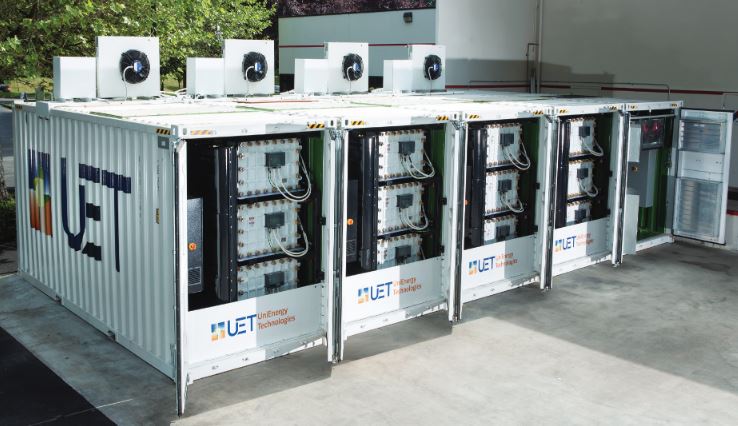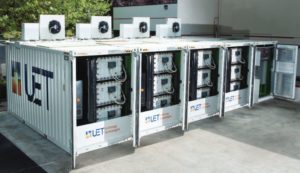New-vanadium-flow battery could have big impact

Uni.Systemâ„¢ delivers 600kW power and 2.2MWh maximum energy in a compact footprint of only five 20' containers.

UniEnergy Technologies (UET) produces turn-key, large-scale energy storage systems for utility, micro-grid, commercial, and industrial applications. At the UET system’s core is an advanced vanadium flow battery, the Uni.Systemâ„¢, which is advertised by the company as safe, operationally flexible, reliable, cost-effective, with a long life expectancy.
The UET redux flow battery (RFB) is a unique electrochemical device that stores electrical energy in liquid electrolytes instead of in electrodes as many other batteries do. The RFB then releases the stored energy according to customer demands at levels up to multi-MW and MWhs.
An RFB cell comprises two electrodes or stacks (made from carbon felt and other items) and two circulating electrolyte solutions (a positive cathode-side electrolyte or catholyte, and a negative anode-side electrolyte or anolyte) separated by an ion exchange membrane or a separator. The energy conversion from electricity energy to chemical potential energy (charge) and vice versa (discharge) occurs instantly within the electrodes as the liquid electrolytes flows through the cell.
The UET storage system provides buffering capabilities between bulk energy generation and subsequent energy use. Energy generated from variable renewables, as well as from other grid resources, is stored and then, when optimal for the grid and or at the micro-grid level, released for use. This buffering can be in many time scales, from less than a second, to hours, to days, and with multiple applications run by the control system.
Like UET’s largerâ€scale Uni.System (500kWAC/2MWhAC), the newly released ReFlex uses UET’s next-generation advanced vanadium technology. According to the company, this technology has a proven safety record, with no thermal runaway risk and a flammability rating of zero. Each system has a 20â€year life with no capacity degradation, and is environmentally safe and recyclable.
The ReFlex controller includes a peak shaving application. Peak shaving is a process that shifts demand from peak times, for example, from noon, to times with lower demand – for example, night. This is done with devices that do not need to run immediately like washing machines.
UET’s Chief Operating Officer, Rick Winter, commented, “We’ve learned a tremendous amount from our utility customers and MWâ€scale installations, which we’ve translated into truly robust plugâ€andâ€play products with remarkable operational flexibility. This allows our customers to address demanding duty cycles, both today and in the future, as they adapt to the rapidly changing power environment and tariff structures. We are particularly excited to bring our robust MWâ€class technology to the kW scale to provide solutions to industrial and commercial, microgrid, and utility customers at that scale.”
UET’s Mark Reynolds says, “UET’s battery solution redefines the grid, and provides the ability to go off-grid forever, or to allow projects to succeed that have no grid access. There is nothing close to their packaged technology.” The technology is so advanced, we cannot yet understand the savings or efficiencies that will accrete to the users of the electrical grid on the Uni-System, (which is pretty well everyone on earth). With storage and precise management we can reduce spinning reserves and peak load leveling to a fraction of today’s limits.
“For off-grid and hospitals worldwide it is a no brainer,” said Reynolds. “It is not my favorite subject, but the military apps are enormous. The UET battery can ramp to full peak load (uni-system 2.2 MW for 1hour) in 0.64 of a millisecond, which is less than a hertz cycle, so there is no interruption to computers or software-based solutions… if we want to develop a new standard we must be able to control electricity more effectively as we are still operating as we did 100 years ago. Nothing has changed since Edison and Tesla. UET has the solution, even though it may not be glaringly obvious yet.”
Based in the Seattle, Washington area, UET operates a 67,000 square foot engineering and manufacturing facility scaling up to produce 100 megawatts annually. Planned deployments by UET in 2016 include projects in California, Italy, New York, Tennessee and Washington State. In 2015, UET deployed the largest containerized flow battery now in operation in the world, as verified by the US Department of Energy Office of Electricity Global Energy Storage Database.
